Alluring Anegada
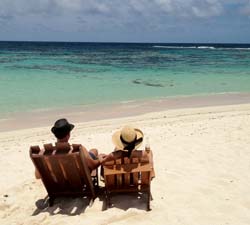
Story and photos by Shaun Clare
Shaun Clare and his wife Anne are members of the Britannia-Rideau squadron. In April 2012 they chartered La Bella Vita, a 42-foot Robertson and Caine Leopard catamaran, and toured the US and British Virgin Islands. They will continue exploring the area in April 2013, and are including Anegada once again on their itinerary. While Anegada is off limits for many charterers, some charter companies may allow their boats to be taken there if the charterer can demonstrate sufficient navigation and sailing experience. Shaun and Anne were required to submit a sailing resumé, which included a transcript of their successfully completed CPS courses. The charter company was confident in their skills and abilities, and they were subsequently approved to go “off the beaten path” and sail to stunning Anegada.
“I see it!” Anne calls out from the bow of our catamaran, upon sighting the channel entry buoy as we approach the low-lying and nearly invisible island of Anegada in the British Virgin Islands. After a gorgeous 12 nautical mile sail from Virgin Gorda, she has spotted the first of several markers that will guide us through a narrow channel leading to the safe waters of a small harbour nestled between Pomato Point to the West, and Setting Point to the East. This entrance, we have read, demands attention, as it is a very thin cut through the reef that surrounds a large portion of the island – a reef that has claimed hundreds of vessels to date.
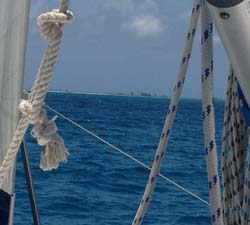 At over 29 kilometers in length, Anegada’s Horseshoe Reef is the fourth largest barrier reef in the world. It begins near the westernmost point of the island, and follows along almost the entire coastline, extending several more miles from the northeast shore.
At over 29 kilometers in length, Anegada’s Horseshoe Reef is the fourth largest barrier reef in the world. It begins near the westernmost point of the island, and follows along almost the entire coastline, extending several more miles from the northeast shore.
In snaking curves towards Virgin Gorda, the vast majority of fish and lobster served in the BVI are caught in or near this reef.
With sails down and now under power, we focus to stay in the center of the channel and slowly make our way into the harbour. The very moment we round the edge of the reef and the harbour opens before us, we notice a monohull sailboat untying and backing off a mooring ball. We give them plenty of leeway and then fall in behind them, attaching La Bella Vita to the same ball. We will be here for two days, and are thrilled that now we won’t need to concern ourselves with the anchor potentially dragging.
Within minutes we’re off in our dinghy heading toward one of three small docks in the harbour. Our first goal is to meet some of the locals and find out more about Anegada, and we soon discover there are only a few small family-run “hotels” on the island, all of them located along the very stretch of beach we are moored next to. Each one has a beach bar, so we decided perhaps a “beach bar crawl” is in order. We make our way along the glorious stretch of white sand, encountering perhaps only 8 or 10 other charterers as we go. The excitement is infectious – I think we all realize just how lucky we are to have this beautiful island virtually to ourselves.
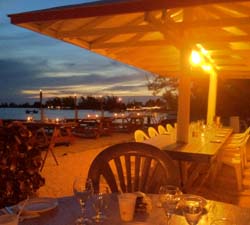 We discover one of the establishments – the Anegada Reef Hotel – offers fresh Caribbean lobster (caught to order), so we book a beach-side table for the next night where we will dine and celebrate Anne’s birthday. After spending the afternoon exploring the various establishments, we decide to head back to the boat, watch the sun set and then fire up the charcoal barbeque conveniently mounted at the stern of our yacht. How do you beat a char-grilled dinner and a nice glass of wine on a gorgeous catamaran in the perfect locale? We can’t think of a way.
We discover one of the establishments – the Anegada Reef Hotel – offers fresh Caribbean lobster (caught to order), so we book a beach-side table for the next night where we will dine and celebrate Anne’s birthday. After spending the afternoon exploring the various establishments, we decide to head back to the boat, watch the sun set and then fire up the charcoal barbeque conveniently mounted at the stern of our yacht. How do you beat a char-grilled dinner and a nice glass of wine on a gorgeous catamaran in the perfect locale? We can’t think of a way.
Soon after, we’re off to bed – with so much more of this paradise to explore tomorrow, we have to rest up!
Anegada is one of only three coral and limestone islands in the BVI (the rest of her sister islands are volcanic in origin). Saba Rock in the North Sound of Virgin Gorda is one, and Sandy Spit, an idyllic, uninhabited “Corona commercial” island southeast of Jost Van Dyke, consisting only of white sand and exactly four palm trees, is the other.
Anegada is virtually flat, with the highest point a mere 28 feet above sea level. Salt ponds are a dominant feature, as is a growing flock of resident flamingos. At nearly 40 square kilometers, it is second in size only to the BVI’s Tortola – yet there are only about 200 people living here. This means, for the time being at least, this treasure of an island is virtually untouched – a Caribbean postcard from the past.
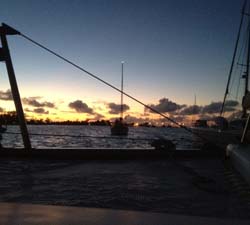 I’m awakened by the smell of coffee, and head up to the galley to fill a cup before heading out to the cockpit to enjoy the early warmth of the sun and the incredible view. There are perhaps 15 boats in the harbour, which might seem congested until one realizes that this is the only protected bay on Anegada – this is a big island to share with such a small number of other visitors.
I’m awakened by the smell of coffee, and head up to the galley to fill a cup before heading out to the cockpit to enjoy the early warmth of the sun and the incredible view. There are perhaps 15 boats in the harbour, which might seem congested until one realizes that this is the only protected bay on Anegada – this is a big island to share with such a small number of other visitors.
As soon as possible we are off in the dinghy again, this time to see if we can find a place to rent a car for the day so we can check out the rest of the island. We speak to the owner of the Anegada Reef Hotel, and he tells us to take a short walk down the beach – at Setting Point there is a place that rents Mopeds and Jeeps. When we arrive we are told they are “sold out” for the day. We explain our plans, and the owner offers her own car for us to use. We sign a one-page moped(!) contract, and she hands us the keys. On our way out she asks that when we return the car, to just leave the keys on the driver’s seat along with the amount of money we think we spent in gas. We are quickly realizing that Anegada is unlike any other place we’ve ever visited.
With only a small map from our sailing guide to get us around, we start down a two-lane sand road that circles the island, and look for some of the spectacular beaches we have read about. In almost no time we come across our first stretch of beach – untouched except for a single palapa and a small wooden fence. In the shade of the palapa are four cows, and off in the distance is an anchored catamaran – otherwise the beach is deserted. The picture I take of this scene is one of my all-time favorites.
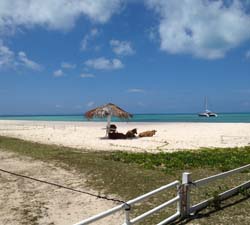 We continue on our way, and before long come across Cow Wreck Beach (which we think would have been a perfect name for the previous spot). There is one small beach bar on this amazing stretch of fine white sand, and the water gleams in every shade of blue, turquoise, and emerald. We can see the breakers crashing on the reef hundreds of meters off shore, but inside the reef where we are standing, the water is calm – like a lagoon. The beach stretches as far as we can see in either direction. We realize that, besides the person in the bar, we are the only people here! We buy a couple of cold beers and sit close by the bar in the shade of a large palm tree. The bartender explains that the bar runs on the honour system. Visitors mix their own drinks and can stay as long as they like, and when they leave, they just put some money in the cash jar that sits on the fridge. We learn that this is typical for beach bars here – we are really starting to “get” Anegada.
We continue on our way, and before long come across Cow Wreck Beach (which we think would have been a perfect name for the previous spot). There is one small beach bar on this amazing stretch of fine white sand, and the water gleams in every shade of blue, turquoise, and emerald. We can see the breakers crashing on the reef hundreds of meters off shore, but inside the reef where we are standing, the water is calm – like a lagoon. The beach stretches as far as we can see in either direction. We realize that, besides the person in the bar, we are the only people here! We buy a couple of cold beers and sit close by the bar in the shade of a large palm tree. The bartender explains that the bar runs on the honour system. Visitors mix their own drinks and can stay as long as they like, and when they leave, they just put some money in the cash jar that sits on the fridge. We learn that this is typical for beach bars here – we are really starting to “get” Anegada.
The desire to continue touring tugs us away from this idyllic spot, and it isn’t long before we come across Loblolly Bay, several kilometers East of Cow Wreck Beach, but on the same unbroken stretch of sand that adorns the North coast of the island. This might be the most “developed” area on the island, with some sidewalks and a few small buildings which contain a beachside grill, watersports rental outlet and beach bar. There are about 15 or 20 other people here, which seems to be about as “crowded” as it gets on Anegada. With steel band music coming from the beach bar, we stay for a while, but eventually we feel the urge to continue to explore, and we move on.
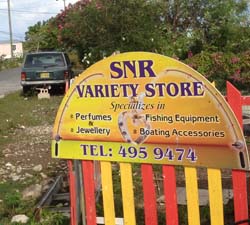 According to our crude map we are now approaching the single village on Anegada – a place called The Settlement. The remnants of stone wall enclosures can be seen throughout the area. These walls delineated fields that were once used to grow corn, bananas, sweet potatoes, and other crops in earlier times when agriculture was required to feed the small population. Today, there are only about 125 dwellings here, along with a bakery, a couple of small restaurants, a pub, the post office, a variety store and a police station.
According to our crude map we are now approaching the single village on Anegada – a place called The Settlement. The remnants of stone wall enclosures can be seen throughout the area. These walls delineated fields that were once used to grow corn, bananas, sweet potatoes, and other crops in earlier times when agriculture was required to feed the small population. Today, there are only about 125 dwellings here, along with a bakery, a couple of small restaurants, a pub, the post office, a variety store and a police station.
After a browse through the store, eclectically “specializing in perfume, fishing equipment, jewelry and boating accessories”, we decide to head back, drop off the car and get ready for Anne’s beachside birthday feast.
That night we enjoy an incredible candlelit meal, under the brightest stars you can imagine (Anegada has almost no lights to compete with the view), and then retire to La Bella Vita for a nightcap and a great night’s sleep.
Tomorrow morning we will set sail for the island of Jost Van Dyke, and stay overnight in the appropriately-named Little Harbour, a very private anchorage. For tonight we’re already planning our next visit to this amazing gem of an island, before heading to bed.
Sweet dreams.
Photo Captions:
Photo 1 – Cow Wreck Beach – paradise almost entirely to ourselves.
Photo 2 – Anedaga is such a low-lying island that it didn’t appear on the horizon until we were almost upon it.
Photo 3 – We enjoyed a wonderful lobster dinner right on the beach at the Anegada Reef Hotel
Photo 4 – Sunrise over Setting Point from the Harbour.
Photo 5 – Another virtually deserted beach with cows relaxing in the shade of a palapa.
Photo 6 – How eclectic – and true to their word, this is exactly what this store in The Settlement carried.




























